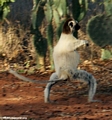Dancing lemur attracts tourists to island of Madagascar
By Rhett Butler, mongabay.com / wildmadagascar.org
May 30, 2005
Updated September 7, 2005
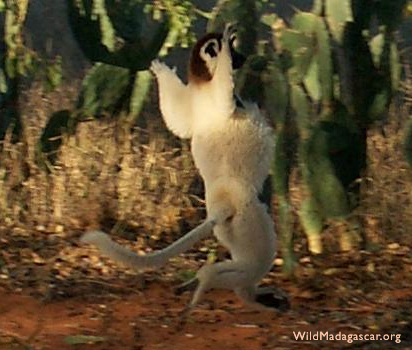
Verreaux’s Sifaka (Propithecus verreauxi verreauxi) doing its dance
In the dry deciduous forests of south western Madagascar there lives a lemur that loudly cusses but “dances” like a ballet performer. Verreaux’s sifaka is among the most popular of lemur species, a group of primates endemic to islands off the southeastern coast of Africa. While threatened, Verreaux’s sifaka is easily spotted in several of Madagascar’s more accessible parks.
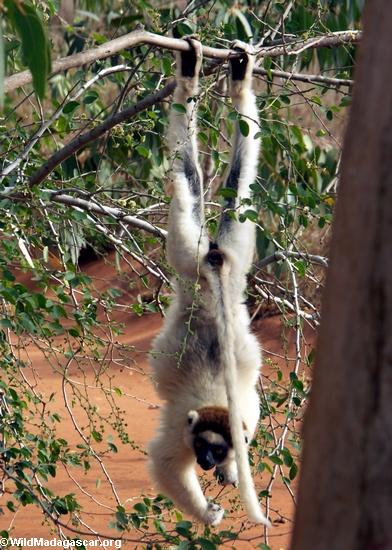 Verreaux’s Sifaka feeding |
A little larger than California, Madagascar is the world’s fourth largest island. Isolated from mainland Africa for about 160 million years, 80% of its native flora and fauna are unique to the island. While Madagascar is best known for its lemurs it also is home to a number of other evolutionary peculiarities from the streaked tenrec, a spiny yellow and black insectivore that resembles a miniature hedgehog and makes grinding-chirping noises when threatened, to the fossa, a carnivorous mammal that looks like a cross between a puma and a dog but is closely related to the mongoose. Madagascar also has more than half the world’s chameleon species, neon green day geckos, three times as many kinds of palm trees as mainland Africa, and an entire ecosystem consisting only of endemic spiny plants. Needless to say, Madagascar’s flora and fauna make it one of the most biologically important places on Earth.
Lemurs are a key component in Madagascar’s biodiversity. Lemurs belong to a group of primates known as prosimians that were once distributed worldwide but today have been largely replaced by monkeys. It is only because of Madagascar’s isolation that lemurs have managed to survive and flourish. Currently about 60 kinds of lemurs are recognized by scientists, a number that has grown in recent years with the discovery of several new species including two this year. Despite these findings, Madagascar’s lemur diversity is considerably poorer than when humans first set foot on the island about 2000 years ago. Since then, the island’s largest lemurs species have been hunted to extinction and suffered from habitat loss induced by climate change and human activities (especially land-clearing with fire).
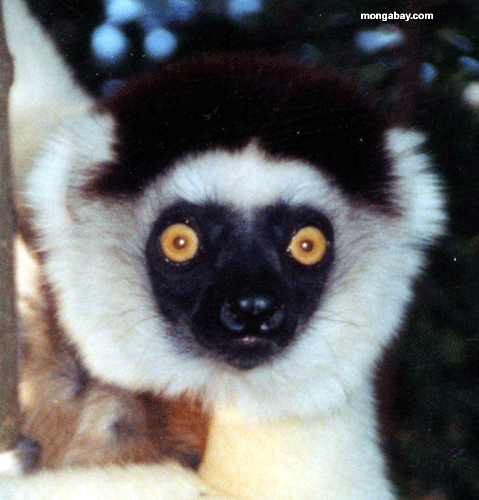 Verreaux’s Sifaka |
Even with these losses, Madagascar’s lemurs display a range of interesting behaviors from singing like a whale (the indri) to extracting insects from tree bark using a long twig-shaped finger (the aye-aye). Among the most amusing of these behaviors is that of Verreaux’s Sifaka, which can be spotted in deciduous forest habitats including Andohahela, Berenty, Beza-Mahafaly, Isalo, and Kirindy.
While sifakas are generally found in trees where they are capable jumpers and feed on fruit, flowers, wood, bark and leaves, they are best known for their “dancing.” Since trees in their habitat are often dispersed, sifakas cross open ground by sashaying on their hind legs with arms aloft. There are few animal sights more entertaining than witnessing a group of sifakas crossing a road.
VIDEO:
Sifakas also have the remarkable ability to leaping from tree to tree in Madagascar’s unique spiny forest where virtually every branch is covered with thorns or spines. How they manage to do this without injuring themselves remains a mystery.
Sifakas generally live in groups of 3-13 individuals — the average group size is around 6 — consisting of roughly equal numbers of adult males and females, and many young. For their daily routine, sifakas patrol a small section of their home page. When they encounter another group there is usually a nonviolent confrontation consisting of territorial displays, growling and scent marking. Within their own group, sifakas communicate with barks, growls, howls, shrieks, and “hums” and their name is derived from their “shifak” alarm call which is used when a potential ground predator is seen. Outside of the breeding season, you’ll often find Sifakas actively playing with each other, though during the breeding seasons males fight with one another for the affections of females who only mate with dominant males.
VIDEO:
The most rewarding time of the year to see Sifakas is August and September when babies are born. Infants ride on the mother’s belly until three months of age, when they are switched to her back. At six to seven months of age sifakas are independent and they are sexually mature at three years.
 Verreaux’s Sifaka pondering its fate |
Like most of the species in Madagascar, Verreaux’s sifaka is threatened by hunting and habitat loss, though to a lesser extent than some of their sifaka relatives (Coquerel’s sifaka, Crowned sifaka, Golden-crowned sifaka, Silky sifaka, and Perrier’s sifaka) found in the eastern rainforests of Madagascar. Due to its popularity and ability to live in altered landscapes , Verreaux’s sifaka is unlikely to face much risk of extinction in the wild. Curiously, in the region around Isalo National Park, this sifaka is known as sifaka-bilany or “sifaka of the cooking pot” reflecting the culinary interests in this species among some Malagasy tribes and immigrants to the area.
What this all means is there is still time to see Verreaux’s sifaka to their “dance” in the strange spiny forests and deciduous habitats of Madagascar. Visiting certain reserves in southwestern Madagascar, this is one lemur (along with the ring-tailed) you are virtually guaranteed to see. The same can not been said for many of Madagascar’s other unique species.
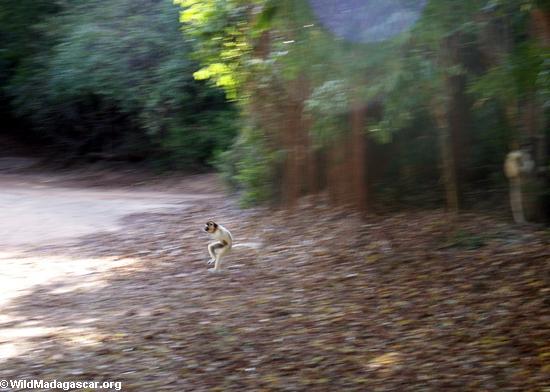
Other articles on Madagascar
- Tourism in Madagascar; Visiting the World’s Most Unusual Island
- Why visit the real island of Madagascar?
- Seeking the world’s strangest primate on a tropical island paradise off Madagascar
- Madagascar looks toward a brighter economic future with movie, new aid package
- Down a river of blood into a remote canyon in Madagascar: Exploring the Manambolo River
- New media resource on the wildlife of Madagscar
- Madagascar Larger Than Life, New Life for Madagascar’s Tourist Industry?
- The Giant Jumping Rat, another peculiarity from Madagascar
- Collapsing vanilla prices will affect Madagascar
- Falling price of rice calms street violence in Madagascar
- In Madagascar woodworking Zafimaniry remember lost forests
Recommended books on Madagascar
- Madagascar: The Bradt Travel Guide
- Madagascar Wildlife: A Visitor’s Guide
- Lonely Planet Madagascar
- The Aye-Aye and I
- The Eighth Continent: Life, Death, and Discovery in the Lost World of Madagascar
- The Natural History of Madagascar
- Malagasy-English/English-Malagasy: Dictionary and Phrasebook
 Save Madagascar T-shirt Sifaka lemur dancing shirt |
 Madagascar Wildlife T-shirt Wildlife of Madagascar |
 Save Madagascar T-shirt Wildlife of Madagascar |
 Wildlife of Madagascar Poster in Malagasy and English |




